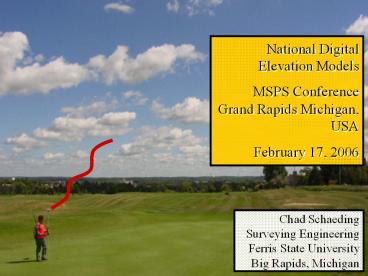February 11, 2000, the Space Shuttle gathered topographi PowerPoint PPT Presentation
1 / 21
Title: February 11, 2000, the Space Shuttle gathered topographi
1
Chad Schaeding Surveying EngineeringFerris
State UniversityBig Rapids, Michigan
National Digital Elevation Models MSPS Conference
Grand Rapids Michigan, USA February 17, 2006
2
Presentation outline
- Introduction to National Digital Elevation Models
- National Elevation Data Set (NED)
- Shuttle Radar Topography Mission (SRTM)
- FREE! From the United States Geological Survey
- Accuracy Analysis Comply w/Mapping Standards
- Applications
- Differentially Rectify Imagery (Orthoimage)
- Conclusions
3
National Elevation Data Set (NED)
- The National Elevation Dataset is the new format
for existing U.S. Geological Survey (USGS)
elevation data - The development of NED began in the early 1990s
and was completely assembled in 1999 - Processing individual 7.5 minute 124,000-scale
(163,360 for Alaska) DEMs - Datum Conversions to NAD83/NAVD88
- Projection Transformation and Resampling
- Artifact Correction
- Edge Matching and Merging with adjacent DEMs
- Seamless form with a consistent datum, elevation
unit, projection, at 10 and 30 meter resolution
(30 and 70 respectively)
4
Photogrammetric Data Acquisition
- Most USGS DEMs were collected using stereo image
pairs adjacent photographs with overlap - High Altitude Aerial Photography Program
5
Shuttle Radar Topography Mission
- February 11, 2000, the Space Shuttle gathered
topographic data over approximately 80 of the
land surfaces of the Earth in only 11 days.
6
SRTM
- Acquired by the National Geospatial-Intelligence
Agency (NGA) and the National Aeronautics and
Space Administration (NASA) utilizing a radar
system that flew onboard the Space Shuttle
Endeavour - SRTM DEM is available with WGS84 datum and EGM96
geoid model - Currently two products are available
- One arc-second resolution (90) for the United
States and its territories - Three arc-second (270) for all the areas
between 60º North and 56º South latitudes
7
What is Radio Detection and Ranging (RADAR)
- Definition A method, system or technique, for
using beamed, reflected, and timed
electromagnetic radiation to detect, locate, and
(or) track objects, to measure altitude and to
acquire a terrain image.
8
Interferometric Synthetic Aperture Radar
- SAR interferometry is a technique involving phase
measurements from successive aircraft or
satellite SAR images to infer differential range
and range changes for the purpose of detecting
very subtle changes on or of the earths surface
with unprecedented scale, accuracy, and
reliability.
9
http//seamless.usgs.gov/
10
Accuracy Analysis of NED and SRTM
- NED SRTM
11
Previous Research of NED and SRTM
- Smith and Sandwell (2003) performed spectral
analysis of the 1-arcsecond SRTM and NED data and
found that following - Root Mean Squared (RMS) of SRTM data is 2.7m
- RMS of the NED data 3.5m
- Reinartz et al (2005) conclude that SRTM data
accuracy decreases drastically in forest areas
since it neither represents the tree canopy or
the ground.
12
National Map Accuracy Standard
- The NMAS defines the following two criteria to
test the vertical accuracy of a topographic map - Vertical accuracy, as applied to contour maps on
all publication scales, shall be such that not
more than 10 percent of the elevations tested
shall be in error by more than one-half the
contour interval - The accuracy of any map may be tested by
comparing the positions of points whose locations
or elevations are shown upon it with
corresponding positions as determined by surveys
of a higher accuracy
13
American Society for Photogrammetry and Remote
Sensing
- The Root-Mean-Square Error (RMSE) statistic is
used to evaluate the accuracy of spatial data is - Class 1 map should have a vertical RMSE of 1/3
the contour interval for well-defined points and
1/6 the contour interval for spot elevations. - Maps compiled within limiting RMSE errors of
twice or three times those allowed for Class 1
map shall be designated as Class 2 or Class 3,
respectively.
14
Case Study, FSU Golf Course
- Evaluating the accuracy of SRTM/NED data
15
Case Study, FSU Golf Course
- Even though USGS standards for DEM require only
28 check points with at least eight scattered
around the edge - More than 500 points were collected in Real-time
Kinematic (RTK) mode - Base Station is the Big Rapids Continuous
Operating Reference Station (CORS) at a distance
of less than 1 mile - Visual inspection on the elevation data and
products compared to more accurate GPS data
16
Case Study, Elevation Results (m)
17
Case Study, Slope Results ()
18
Orthophotographs
- Orthophotography is a geometrically corrected
photograph created from either aerial or
satellite imagery - The most expensive part of producing an
orhtophoto is generally the creation of the DEM
19
Case study, the FSU golf course
- Two orthophotographs were created using the Leica
Photogrammetry Suite from 110,000-scale
photography taken at a flight height of 1,582
meter above the average terrain and scanned at
ground resolution of 0.15 meters - The initial NED and SRTM DEMs were projected from
their native geographic coordinates to Michigan
Plane coordinate system to create a 35x35 meter
resolution DEM
20
Concluding Remarks
- From the results of experiments undertaken in
this study, it is clear that these government
datasets can be used to create orthophotos at a
scale of 110,000 that meet acceptable industry
standards such as those developed by ASPRS. - This study found that the SRTM data had slightly
better accuracy than the NED data but it may not
represent the terrain properly and may have
larger errors in computing slope and aspect
parameters. It is also important to note that the
SRTM data is a DSM while NED data is a DEM
measuring ground topography. - SRTM data is current which is an important
advantage providing a proper model that can be
used for many applications, even for updating the
NED.
21
Questions
The support for this research from the National
Geospatial-Intelligence Agency under contract no.
HM1582-04-1-2026 is greatly acknowledged.

